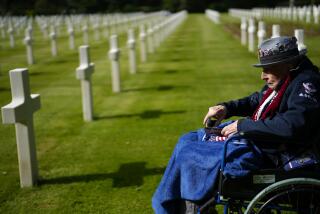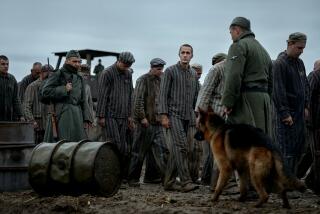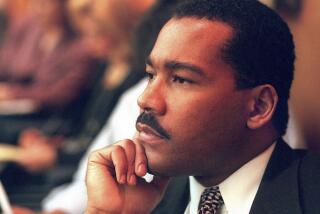My father, defined by war
His Army serial number was 35157289.
He lived in Indiana in the county of Randolph, where he worked in a glass factory. In April 1941, my father, Sheldon Scott King, became part of the peacetime draft, entering the service at Fort Benjamin Harrison in Indiana. Then came the attack on Pearl Harbor that year, and like so many young men of his generation, he went off to war -- as was so poignantly captured in HBO’s recent miniseries “The Pacific.”
My father shipped out to Australia and then on to the jungles of New Guinea, where he eventually became a staff sergeant. There, he became part of the repair squadron for the 27th Air Depot Group.
My father, who died at age 90 four years ago, never talked much about his war experiences. There were bits here and there.
The weather was awful. They lived in tents. There were a lot of rats. Comedian Joe E. Brown came to perform, but he wasn’t very good.
We never could eat lamb when he was home because he said the smell reminded him of the tough mutton that was served on the ship traveling from the U.S. to Melbourne.
But the war defined him.
After the war, he became an airplane mechanic for Eastern Airlines in New York and later a flight engineer for that airline. That’s where he met my mother, who was a stewardess for the airline. Eventually, he went to work for the Federal Aviation Administration -- first in San Francisco and for the last 17 years of his career in Denver. He retired at 71.
My father’s reticence about the war was the norm for the World War II veterans, according to Sam Wegner of the National World War II Museum in New Orleans.
“When they came out, they said, ‘We got the job done,’ ” he said. “They don’t make a big deal of what they accomplished. We are in the Eisenhower era where everybody is feeling great.”
With the Vietnam War, said Wegner, everything military became taboo.
“Then there is this odd convergence of things, movies like ‘Saving Private Ryan’ suddenly shed light on what happened,” added Wegner. “That generation is getting to the point [in the1990s] where they are beginning to look at the end of their lives and they are looking back to see what they accomplished and realized they did great things. They begin to share their stories. That led to the creation of this museum. It also led back to popular culture beginning to say, ‘There are some great things that happened,’ and that is why you have a series like ‘Band of Brothers’ and ‘The Pacific.’ ”
“The Pacific,” which ended its 10-week run on May 16 -- the fourth anniversary of my father’s death -- has been well received by the museum and vets, said Wegner. In fact, he added, visits to the museum’s 5,000-square-foot “D-Day Invasions in the Pacific” exhibit have gone up dramatically since the series.
At the end of World War II, there were about 16 million men and women alive who served in uniform.
“I think we are down to either 1.5 or 2 million,” Wegner said. Estimates are that some 900 World War II vets die each day.
“When we are talking of a passing of a generation, we are literally seeing a passing of a generation,” said Wegner.
Last fall, my mother, Mary, had two amazing items for me.
One was the “New Guinea Diary,” sort of a yearbook that chronicled the 27th Air Depot Group from 1942-44. The other was a photo album filled with striking photos of my father -- and his fellow soldiers -- taken during those hot, muddy years in the jungles far away from his home.
And in honor of Memorial Day and my dad, who was quite handsome in his uniform, I open up the photos from the album.
More to Read
The complete guide to home viewing
Get Screen Gab for everything about the TV shows and streaming movies everyone’s talking about.
You may occasionally receive promotional content from the Los Angeles Times.







